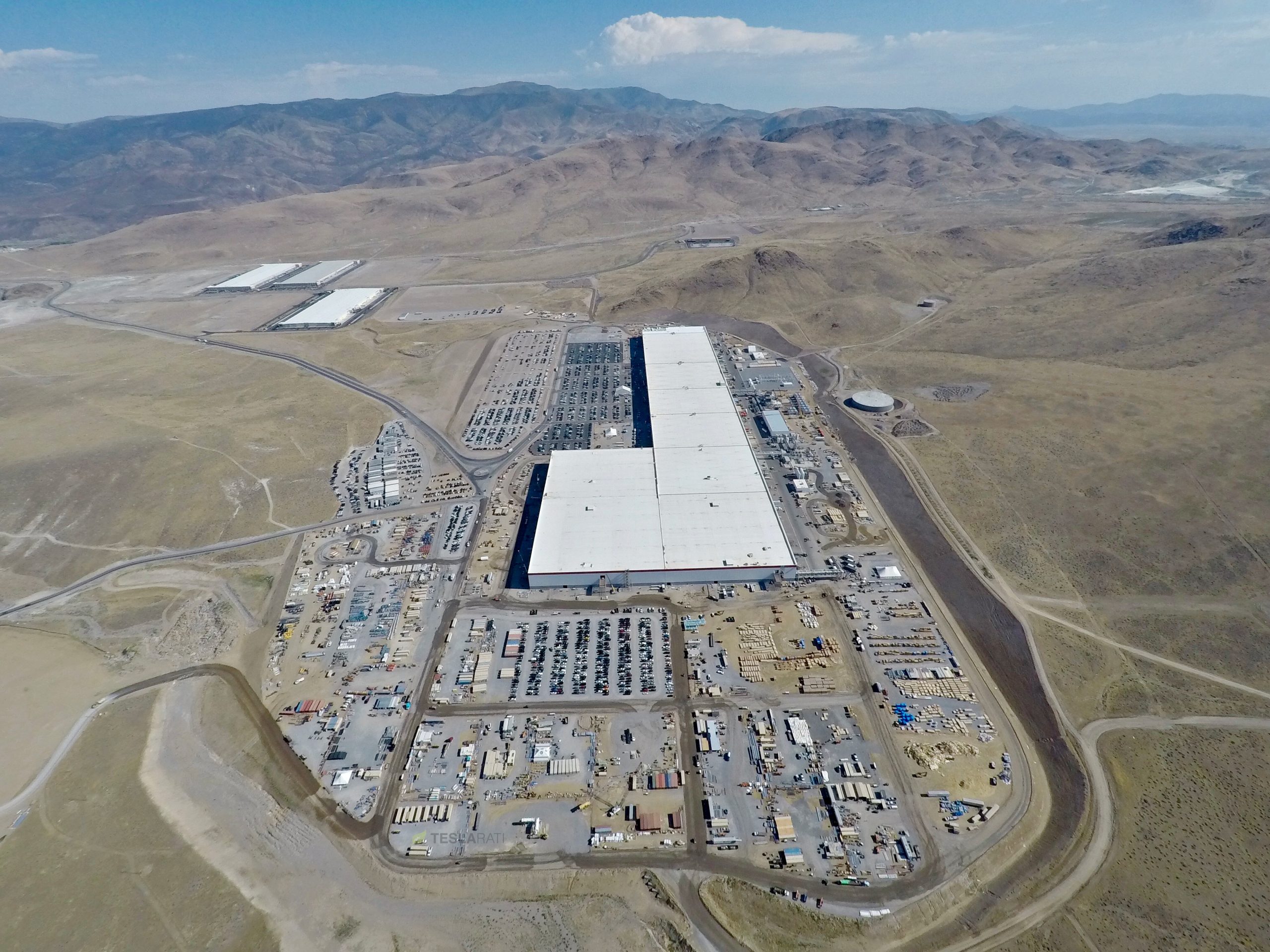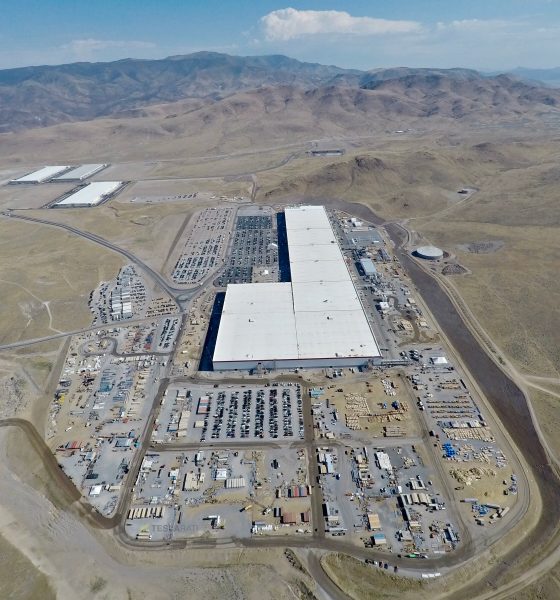

Energy
Elon Musk ramps hiring effort for Tesla’s Gigafactory battery factory
Operations are ramping up at Tesla Gigafactory 1, with CEO Elon Musk inviting interested individuals to apply for a job at the massive battery plant in Sparks, Nevada. Considering the timing of Musk’s most recent announcement, it seems like the California-based firm is gearing up for a massive increase in activity as the Model 3 approaches its target production numbers.
The invitation to join the Gigafactory team was posted on Twitter and included a touch of Musk’s trademark wit and spontaneity.
“Come work at the biggest & most advanced factory on Earth! Located by a river near the beautiful Sierra Nevada mountains with wild horses roaming free.”
A link to the careers page on Tesla’s site reveals that the company is looking for various technicians, material handlers, engineers, managers, production associates, and many more. Overall, the available job postings for the Gigafactory invoke an air of expansion, as Tesla continues to ramp up battery production of its latest and possibly most disruptive car to date — the Model 3.
Join our Gigafactory team https://t.co/E2tgdxmjpU
— Tesla (@Tesla) January 3, 2018
Tesla’s $5 billion factory is arguably the heart that gives life to the company’s vision for a sustainable future, producing batteries and energy products such as the Powerwall and commercial Powerpack battery storage system. Gigafactory 1 is also the facility where Model 3’s battery and powertrain are being manufactured.
During Tesla’s Q3 2017 earnings call, Musk directly addressed the Gigafactory’s workers and the lack of manpower for the Model 3 line. According to Musk, Tesla ended up pulling the third shift of workers from the Model S and Model X line in order to help out the Model 3 labor pool, since the company was running out of manpower for the mass market electric sedan.
“We also just needed much people on (the) Model 3 line. So we thought we will take the third shift from Model S and the X, and apply it to Model 3. Because really, running out of the labor pool, honestly. It’s like we’re sucking the labor pool dry both in Gigafactory and in Fremont. It’s just so many people that can make it to the Gigafactory.”
The increase in activity at Tesla’s battery plant has recently been touted as being the root cause for an ‘extreme’ global shortage of cylindrical batteries, as demand for battery powered products, even beyond electric vehicles, continue to soar.
“It is impossible to purchase cylindrical batteries within Japan and we were even notified by Panasonic that they are not going to sell cylindrical batteries anymore.” said a representative for a Japanese battery distributor,. “It has come to a point where we cannot even purchase products from Samsung and LG and even products from Samsung and LG that were produced in China.”
In addition to increasing efforts to ramp its workforce at its Nevada-based battery factory, Tesla’s Gigafactory 2 in Buffalo, N.Y., a factory dedicated to producing solar cells for the company’s line of solar panels and Solar Roof product, has headed early efforts to bring nearly 3,000 jobs to the Buffalo area, as the company aims for volume production of solar products in 2019.

Cybertruck
Tesla updates Cybertruck owners about key Powershare feature

Tesla is updating Cybertruck owners on its timeline of a massive feature that has yet to ship: Powershare with Powerwall.
Powershare is a bidirectional charging feature exclusive to Cybertruck, which allows the vehicle’s battery to act as a portable power source for homes, appliances, tools, other EVs, and more. It was announced in late 2023 as part of Tesla’s push into vehicle-to-everything energy sharing, and acting as a giant portable charger is the main advantage, as it can provide backup power during outages.
Cybertruck’s Powershare system supports both vehicle-to-load (V2L) and vehicle-to-home (V2H), making it flexible and well-rounded for a variety of applications.
However, even though the feature was promised with Cybertruck, it has yet to be shipped to vehicles. Tesla communicated with owners through email recently regarding Powershare with Powerwall, which essentially has the pickup act as an extended battery.
Powerwall discharge would be prioritized before tapping into the truck’s larger pack.
However, Tesla is still working on getting the feature out to owners, an email said:
“We’re writing to let you know that the Powershare with Powerwall feature is still in development and is now scheduled for release in mid-2026.
This new release date gives us additional time to design and test this feature, ensuring its ability to communicate and optimize energy sharing between your vehicle and many configurations and generations of Powerwall. We are also using this time to develop additional Powershare features that will help us continue to accelerate the world’s transition to sustainable energy.”
Owners have expressed some real disappointment in Tesla’s continuous delays in releasing the feature, as it was expected to be released by late 2024, but now has been pushed back several times to mid-2026, according to the email.
Foundation Series Cybertruck buyers paid extra, expecting the feature to be rolled out with their vehicle upon pickup.
Cybertruck’s Lead Engineer, Wes Morrill, even commented on the holdup:
As a Cybertruck owner who also has Powerwall, I empathize with the disappointed comments.
To their credit, the team has delivered powershare functionality to Cybertruck customers who otherwise have no backup with development of the powershare gateway. As well as those with solar…
— Wes (@wmorrill3) December 12, 2025
He said that “it turned out to be much harder than anticipated to make powershare work seamlessly with existing Powerwalls through existing wall connectors. Two grid-forming devices need to negotiate who will form and who will follow, depending on the state of charge of each, and they need to do this without a network and through multiple generations of hardware, and test and validate this process through rigorous certifications to ensure grid safety.”
It’s nice to see the transparency, but it is justified for some Cybertruck owners to feel like they’ve been bait-and-switched.
Energy
Tesla starts hiring efforts for Texas Megafactory
Tesla’s Brookshire site is expected to produce 10,000 Megapacks annually, equal to 40 gigawatt hours of energy storage.

Tesla has officially begun hiring for its new $200 million Megafactory in Brookshire, Texas, a manufacturing hub expected to employ 1,500 people by 2028. The facility, which will build Tesla’s grid-scale Megapack batteries, is part of the company’s growing energy storage footprint.
Tesla’s hiring efforts for the Texas Megafactory are hinted at by the job openings currently active on the company’s Careers website.
Tesla’s Texas Megafactory
Tesla’s Brookshire site is expected to produce 10,000 Megapacks annually, equal to 40 gigawatt hours of energy storage, similar to the Lathrop Megafactory in California. Tesla’s Careers website currently lists over 30 job openings for the site, from engineers, welders, and project managers. Each of the openings is listed for Brookshire, Texas.
The company has leased two buildings in Empire West Business Park, with over $194 million in combined property and equipment investment. Tesla’s agreement with Waller County includes a 60% property tax abatement, contingent on meeting employment benchmarks: 375 jobs by 2026, 750 by 2027, and 1,500 by 2028, as noted in a report from the Houston Business Journal. Tesla is required to employ at least 1,500 workers in the facility through the rest of the 10-year abatement period.
Tesla’s clean energy boom
City officials have stated that Tesla’s arrival marks a turning point for the Texas city, as it highlights a shift from logistics to advanced clean energy manufacturing. Ramiro Bautista from Brookshire’s economic development office, highlighted this in a comment to the Journal.
“(Tesla) has great-paying jobs. Not just that, but the advanced manufacturing (and) clean energy is coming to the area,” he said. “So it’s not just your normal logistics manufacturing. This is advanced manufacturing coming to this area, and this brings a different type of job and investment into the local economy.”
Energy
Tesla and Samsung SDI in talks over new US battery storage deal: report
The update was related by industry sources and initially reported by South Korean news outlets.

Recent reports have suggested that Tesla and Samsung SDI are in talks over a potential partnership to supply batteries for large-scale energy storage systems (ESS).
The update was related by industry sources and initially reported by South Korean news outlets.
ESS batteries to be built at Samsung’s Indiana plant
As noted in a report from Korea JoongAng Daily, the demand for energy storage systems has been growing rapidly in North America, thanks in no small part to the surge in AI investments across numerous companies. With this in mind, Tesla has reportedly approached Samsung SDI about a potential battery supply deal.
The deal is reportedly worth over 3 trillion Korean won (approximately $2.11 billion) and will span three years, according to The Korea Global Economic Daily. A battery supply deal with Samsung SDI could make sense for Tesla as the company already has a grid-scale battery, the Megapack, which is perfect for industrial use. Samsung SDI could simply supply cells for the EV maker.
Production of the batteries would reportedly take place at Samsung SDI’s joint venture factory with Stellantis in Indiana, which is currently under construction. Samsung SDI recently announced plans to use part of that plant’s EV lines to produce cells for ESS, with a targeted capacity of 30 GWh by the end of next year.
Tesla and Samsung’s partnership
At present, only a handful of manufacturers, including Korea’s LG Energy Solution, Samsung SDI, SK On, and Japan’s Panasonic, are capable of producing energy storage-scale batteries domestically in the United States. A Samsung SDI official issued a comment about the matter, stating, “Nothing has been finalized regarding cooperation with Tesla.”
The possible energy storage system deal adds another layer to Tesla’s growing collaboration with Samsung, which is already in line as a partner in the upcoming production of Tesla’s AI5 and AI6 chips. Early sample manufacturing of the AI6 is expected to begin in South Korea, with mass production slated for Samsung’s Texas-based Taylor foundry when it starts operations.
The AI6 chip will power Tesla’s next wave of high-volume projects, including the Optimus humanoid robot and the autonomous Cybercab service. Musk has called the partnership with Samsung a “real collaboration,” adding that he personally plans to “walk the line” at the Taylor facility to speed up progress.








